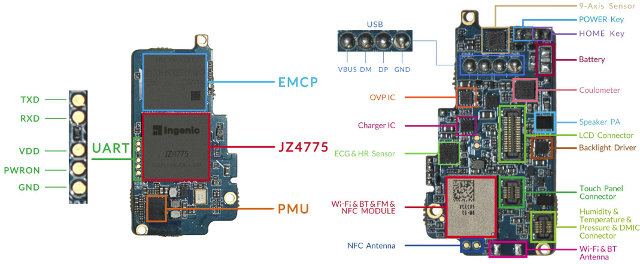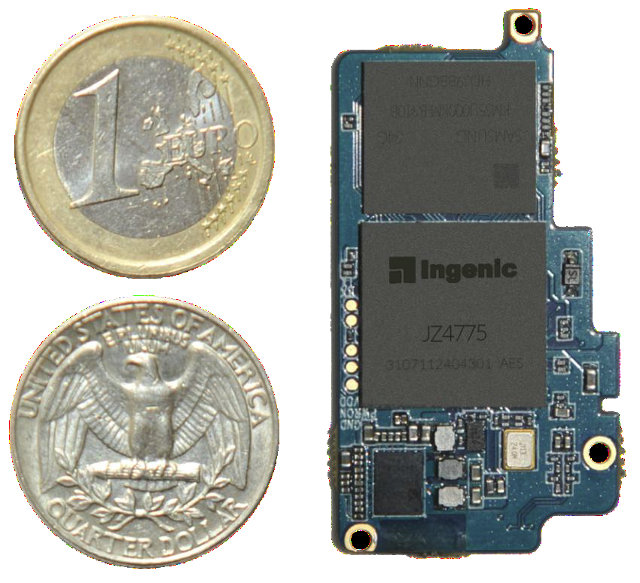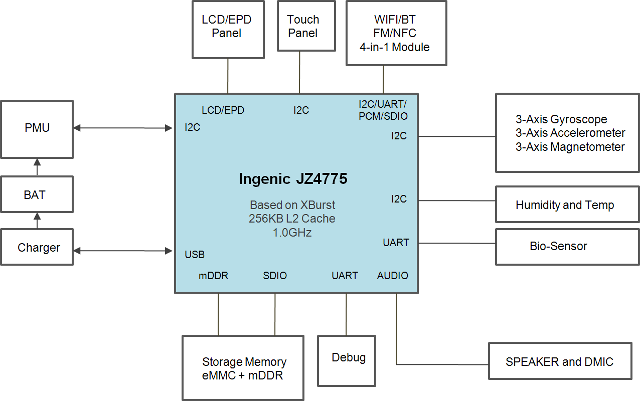Imagination Technologies has published a blog post about Newton, a tiny reference design for wearables based on Ingenic JZ4775 MIPS SoC found in some recent smartwatches such as SmartQ Z1 (The CPU not the module). This module targets wearables, IoT, healthcare, home appliances, security, industrial control, consumer electronics and more.
Newton Specifications:
- SoC – Ingenic JZ4775 MIPS Xburst processor @ 1 GHz with 2D GPU, and VPU supporting 720p@30fps for MPEG-2, MPEG-4, VC-1, H.264, VP8, and RV9 codecs.
- System Memory – Up to 3GB mobile DDR3/DDR2/LPDDR1
- Storage – Up to 32 GB eMCP eMMC flash
- Display Support – LCD or EPD, with touch panel and backlight
- Audio – Digital MIC and Speaker
- Connectivity – 4-in-1 combo with Wi-Fi (802.11 a/b/g/n at 2.4/5 GHz), Bluetooth 4.0 + EDR (including Bluetooth LE support), NFC, and FM
- Sensors – 3-axis gyroscope, accelerometer magnetometer, pressure, humidity and temperature, bio-signal detection and processing
- USB – USB OTG signals
- Expansion ports – UART, I2C, USB, GPIO, and “motor” support (PWM?)
- Power Supply – USB (5V) or Battery (3.7 to 4.2V) with PMU and charger
- Power Consumption – Standby power: 4mW, MP3 playback: 100mW on average, with peak power consumption at ~260mW.
- Dimensions – 21.6mm x 38.4mm x 3.2mm (But hardware manual: Max size is 41.4mm x 21.6mm)
Linux 3.0.8, Android 4.4 KitKat and several real-time operating systems have already been ported to the Newton platform, and developers/customers can access the open source drivers. Ingenic can also provide software packages for voice or gesture control for user interfaces.
During Google recent Android Wear announcement, Google mentioned Broadcom, Intel, Mediatek and Qualcomm, as well as Imagination Technolgies as key SoC and IP partners, so this module might also be used in devices running Android Wear. This was strongly implied in Imagination’s blog post, but they never explicitly confirmed Ingenic Newton was an Android Wear platform.

Neither pricing and availability have been disclosed. Since they will only provide source code to “customers”, I doubt this type of module will be available to hobbyists. Further details about the module, including an hardware reference manual, are available on Ingenic Newton page.

Jean-Luc started CNX Software in 2010 as a part-time endeavor, before quitting his job as a software engineering manager, and starting to write daily news, and reviews full time later in 2011.
Support CNX Software! Donate via cryptocurrencies, become a Patron on Patreon, or purchase goods on Amazon or Aliexpress







good project, but where is the schematic diagram?